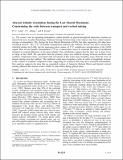Abyssal Atlantic circulation during the Last Glacial Maximum: Constraining the ratio between transport and vertical mixing
Author(s)
Ferrari, Raffaele; Lund, D. C.; Adkins, Jess F.
DownloadFerrari_Abyssal Atlantic.pdf (1.122Mb)
PUBLISHER_POLICY
Publisher Policy
Article is made available in accordance with the publisher's policy and may be subject to US copyright law. Please refer to the publisher's site for terms of use.
Terms of use
Metadata
Show full item recordAbstract
The ocean's role in regulating atmospheric carbon dioxide on glacial-interglacial timescales remains an unresolved issue in paleoclimatology. Reduced mixing between deep water masses may have aided oceanic storage of atmospheric CO[subscript 2] during the Last Glacial Maximum (LGM), but data supporting this idea have remained elusive. The δ[superscript 13]C of benthic foraminifera indicate the Atlantic Ocean was more chemically stratified during the LGM, but the nonconservative nature of δ[superscript 13]C complicates interpretation of the LGM signal. Here we use benthic foraminiferal δ[superscript 18]O as a conservative tracer to constrain the ratio of meridional transport to vertical diffusivity in the deep Atlantic. Our calculations suggest that the ratio was at least twice as large at the LGM. We speculate that the primary cause was reduced mixing between northern and southern component waters, associated with movement of this water mass boundary away from the zone of intense mixing near the seafloor. The shallower water mass boundary yields an order of magnitude increase in the volume of southern component water, suggesting its residence time may have increased substantially. Our analysis supports the idea that an expanded volume of Antarctic Bottom Water and limited vertical mixing enhanced the abyssal ocean's ability to trap carbon during glacial times.
Date issued
2011-03Department
Massachusetts Institute of Technology. Department of Earth, Atmospheric, and Planetary SciencesJournal
Paleoceanography
Publisher
American Geophysical Union (AGU)
Citation
Lund, D. C., J. F. Adkins, and R. Ferrari. “Abyssal Atlantic Circulation During the Last Glacial Maximum: Constraining the Ratio Between Transport and Vertical Mixing.” Paleoceanography 26.1 (2011). ©2012 American Geophysical Union
Version: Final published version
ISSN
0883-8305